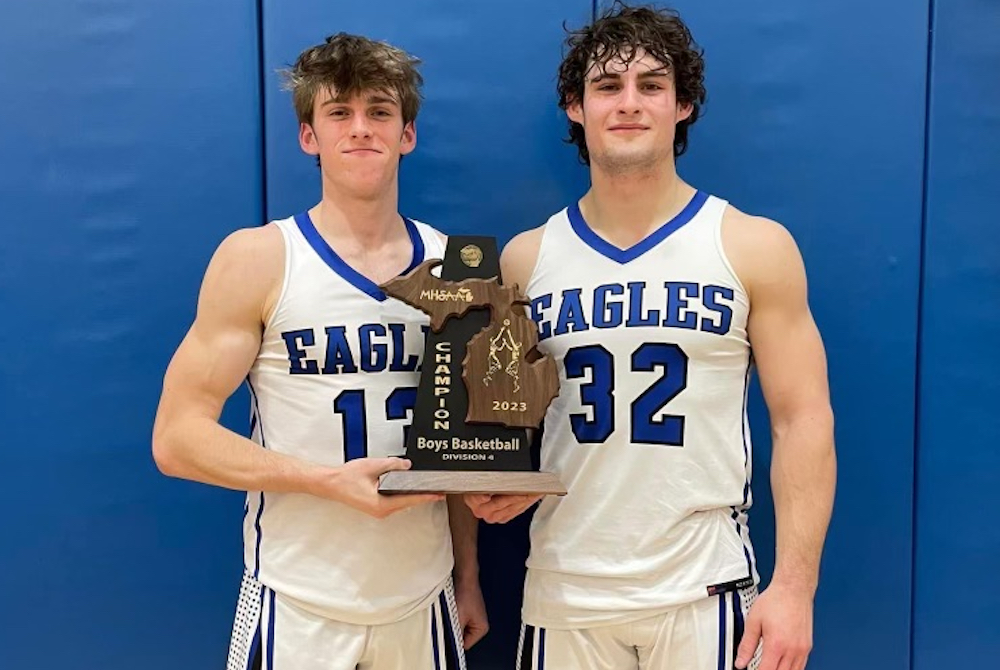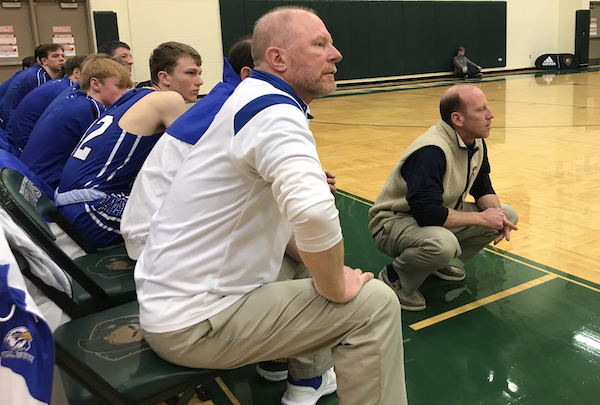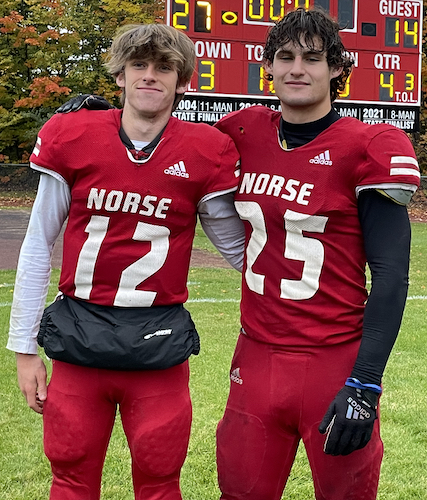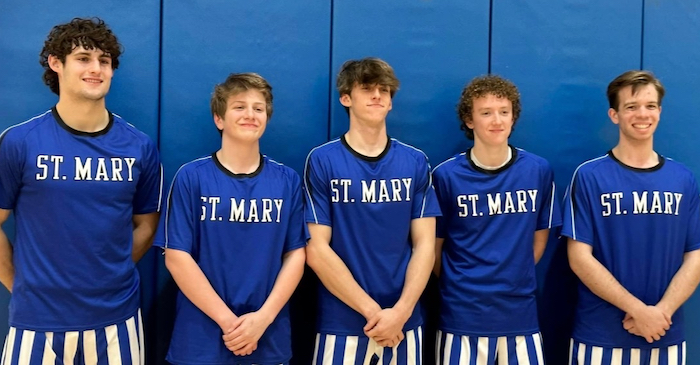
Before the Bridge: Class E & the UP
July 31, 2017
By Ron Pesch
MHSAA historian
This is the final part in a series on MHSAA tournament classification, past and present, that has been published over the last two weeks and originally ran in this spring's edition of MHSAA benchmarks.
The stories are worthy of the silver screen.
Long lost legends of lore, forgotten by most in the Lower Peninsula of the state of Michigan.
Absurd anecdotes of basketball played behind glass, and out-of-bounds lines painted on walls.
Tales of overlooked places like Trenary and Champion and Doelle and Watersmeet.
This is the story of MHSAA Class E basketball.
From 1932 to 1947, Michigan's Upper Peninsula did not compete in the state-sponsored basketball tournament. Instead, the U.P. held a separate basketball tournament, crowning champions in Classes B, C and D. In 1941, the state added a fifth classification – Class E, comprised of schools with a student body numbering 75 or fewer. A fourth bracket was added to the U.P. tourney.
Following the 1948 season, the Upper Peninsula returned to the state tournament. Winners of the traditional U.P. tourney were pronounced regional champions, and advanced to the state quarterfinals in Classes B, C and D. However, since there were no Class E schools with basketball teams in the Lower Peninsula, the winner of the U.P. tournament crown was proclaimed Class E state champion. This arrangement continued through the spring of the 1960 season.
Since they were the state's smallest high schools, the gymnasiums came in all shapes and sizes. Some sported a center circle that intersected with the top of the key. Basketball courts that doubled as a stage required netting to keep the kids and the ball on the court and away from the audience seated below.
Fred Boddy, a former coach at Champion, recalled his first visit to Doelle. Located in copper country near Houghton, the hosts were the proud owners of “the smallest” gym in U.P.
“I couldn't believe my eyes. ... Here on the second floor were windows and bleachers all around filled with fans. The gym, of course, was located on the first floor, but to get into the gym one had to go around to the back of the school to enter through the boiler room to the locker rooms, which opened onto the gym floor much like a dugout on a baseball field. The players sat on a bench under the wall and could look out and see the game in this manner. The free throw lines intersected and there were no out of bounds lines... the wall itself was ‘out of bounds.’ On the floor during the game were 10 players and two referees. There were no sounds as all the fans were up on the second floor, glassed in.
The cheerleaders tried valiantly to fire up the fans up on the second floor, but the teams couldn't hear in the quiet below. The score clock and statistician personnel were placed in a corner box high over the floor in one corner of the gym. They attained this lofty perch by a ladder that was removed from the trap door after all three were in position and the game could thus commence. The timer then tied a rope around his ankle. To send a sub into the game the coach would send the player along the wall heading for this rope. He would pull the rope causing the timer to look down through the trap door and at next opportunity would ring the buzzer and admit this substitute”
Regardless of the challenges presented by these cracker-box gyms, the fans loved their basketball. “The enthusiasm was just the same, if not bigger, than schools twice and 10 times their size,” noted longtime U.P. historian, Jay Soderberg.
Coach Joseph Miheve's 1941 Palmer squad captured the state's first Class E title with a 39-28 win over Hulbert at Ironwood. A graduate of Wakefield High School, Miheve had never played high school basketball, serving as the team's manager.
The 1942 tournament, scheduled for March 19-21, was postponed one week because the city of Marquette was more or less taken over “by nearly 1,000 selective service registrants from every county in the Upper Peninsula” who had another and more serious battle in mind – World War II.
Palmer, this time coached by Elvin Niemi, repeated in Class E with a 37-31 victory over Bergland. It was Palmer's 32nd consecutive victory.
No tournament was held in 1943 due to the involvement of the United States in the war. In the 1944 championship game, Cedarville jumped out to a 19-14 first quarter lead but was held to 24 points in the remaining periods and fell to Amasa, 51-43 at Ishpeming.
Trenary made its lone Class E finals appearance in 1945, losing to Bergland 49-39 at Ishpeming, while the Alpha Mastodons won their first U.P. title since 1934 with a 48-28 win over Champion in 1946. It was the second of five Class E titles for Alpha coach Gerhardt “Gary” Gollakner, one of the finest coaches to come out of the U.P. Gollakner had coached at Amasa two years earlier, and his Mastodons would earn three additional titles during the 19-year run of the Class E championships.
Bergland became the tourney's second two-time winner in 1947, with a 40-37 win over the Perkins Yellowjackets. Perkins made four trips to the Class E finals over the years, including an appearance in the final year of the tournament, but came away empty-handed each time.
The Nahma Arrows made their first appearance in the championship in 1951, losing to Michigamme. Led by coach Harold “Babe” Anderson, a cage star at Northern Michigan College during the early 1940s, the Arrows returned to the finals in 1952. Nahma finished the year with a 21-0 mark and a 64-44 win over Marenisco for the crown.
 The two teams met again in a finals rematch the following year. The scored was tied six times, while the lead changed hands seven times in this barnburner. With 15 seconds to play, Nahma led 64-60. Marenisco's Robert Prosser hit a jump shot, then teammate Bill Blodgett stole a pass and scored to knot the game at 64. With two seconds remaining, Nahma's Bernard Newhouse was fouled. Newhouse hit the first free throw, but missed on the second. Teammate Wendell Roddy tipped in the rebound, and the Arrows had their second title.
The two teams met again in a finals rematch the following year. The scored was tied six times, while the lead changed hands seven times in this barnburner. With 15 seconds to play, Nahma led 64-60. Marenisco's Robert Prosser hit a jump shot, then teammate Bill Blodgett stole a pass and scored to knot the game at 64. With two seconds remaining, Nahma's Bernard Newhouse was fouled. Newhouse hit the first free throw, but missed on the second. Teammate Wendell Roddy tipped in the rebound, and the Arrows had their second title.
Alpha returned to the championship circle in 1954 with a 52-48 win over Perkins.
The 1955 title game matched a pair of the finest teams in Class E history. Trout Creek, making its first championship appearance, downed Alpha 84-83 in another Class E thriller. Don Mackey led the winners with 39 points. Tony Hoholek paced Alpha with 31, while junior John Kocinski added 21-points for the Mastodons.
Kocinski, a four-year starter at Alpha, scored 1,782 points during his career, then an all-time U.P. record. He once scored 51 points against Amasa, and could have scored more according to teammate Walter “Slip” Ball. “He refused to shoot in the fourth quarter, and passed up one shot after another,” Ball said.
Without question, Trout Creek was one of the powerhouse squads during the final years of the tourney. The Anglers, coached by Bruce “Pinky” Warren, a former captain of Purdue's football team, made four trips to the finals during the last six years of the Class E tourney. The defending champions downed Alpha in the semifinals of the 1956 tournament, then knocked off Hermansville 86-68 in the finals to repeat. It was a year of celebration for fans of U.P. basketball, as four of the state's five champions – Stephenson (B), Crystal Falls (C), Chassell (D) and Trout Creek (E) – came from Michigan's northern peninsula.
Hermansville returned to the finals in the spring of 1957 and earned its second Class E title with a 77-51 win over Michigamme at Escanaba. Trout Creek downed Perkins 61-41 for their third crown in 1958.
The 1959 championship, hosted at Northern Michigan College's fieldhouse, was a showdown of the U.P.’s only undefeated squads, Trout Creek and Nahma. Trout Creek was riding a 24-game winning streak that dated back to the 1958 season. A scoring machine, Warren's Anglers averaged 81.7 points per contest. Nahma, 19-0 on the season, boasted the U.P.'s strongest defense. Still coached by “Babe” Anderson, the Arrows had allowed an average of 38.2 points per game. Led by senior Warren Groleau, Nahma had been last defeated by Trout Creek in the semifinals of the 1958 tourney.
Leading 25-15 at the intermission, Nahma matched Trout Creek point for point in the second half for a 55-45 victory.
Hermansville, behind Richard Polazzo's 29 points and Irwin Scholtz's 27, downed surprise finalist Perkins 72-50 in the 1960 finale, to end this chapter in MHSAA history.
Today, most of the former Class E high schools are long gone. Many have closed their doors and consolidated with other area schools. Amasa and Alpha merged with Crystal Falls to form Forest Park. Palmer is now part of the Negaunee school system. Bergland and Trout Creek joined forces with Class D Ewen to form Ewen-Trout Creek. Hermansville combined with Powers to form North Central, to name but a few. A few remain: Dollar Bay, Marenisco (now Wakefield-Marenisco) and Watersmeet, and their enrollments are much the same as in the glory days of the state's fifth classification.
Author’s note: Special thanks to Jay Soderberg and Roger Finlan, who assisted in gathering statistics and quotes used in this article. Thanks also to Dick Kishpaugh, Bob Whitens, Walter “Slip” Ball, Dennis Grall, Fred Boddy, Bruce Warren, Gene Maki, Harold “Babe” Anderson and the various personnel at U.P. high schools for their contributions to this story.
PHOTOS: (Top) The Alpha boys basketball team won the 1950 Class E title by nearly doubling up Michigamme, 52-28. (Middle) Hermansville claimed the 1948 title with a 58-38 win over Rockland.

For Their Teams, For Each Other, St. Mary Seniors Team Up 2 More Times
By
Tom Spencer
Special for MHSAA.com
March 17, 2023
Shawn Bramer and Dylan Barnowski, as middle schoolers, attended the MHSAA Boys Basketball Finals every year.
 Last year, they nearly played in the Division 3 title game – falling in a Semifinal but almost making a dream come true for the then-juniors and their Lake Leelanau St. Mary coach, Matt Barnowski, also Dylan’s father.
Last year, they nearly played in the Division 3 title game – falling in a Semifinal but almost making a dream come true for the then-juniors and their Lake Leelanau St. Mary coach, Matt Barnowski, also Dylan’s father.
That dream began for some when the boys were coached by Matt as third graders, and they made serious strides last season. Before last winter, the last time the Eagles had won a Regional championship was 1950 – and no St. Mary boys basketball team had reached the Semifinals. Bramer and Dylan Barnowski – along with current seniors Jack Glynn, Drew Thompson and Nick Linguar – had high hopes of making more history this winter.
The dream ended Wednesday night with a Regional Final loss to Frankfort, which St. Mary had defeated 54-41 during the regular season. This time, the Eagles were faced with a large number of K-12 students succumbing to illness – with all five of its starters at least somewhat sick – as nearly a third of the school’s tiny enrollment was out of school the day after the loss to the Panthers.
But you won’t hear any of the players or coaches making excuses. They give all the credit to Frankfort, and they’re ready to move on. And many in the LSM family know reaching the Regional Finals this season and Breslin Center in 2022 had absolutely no probability had Bramer and Barnowski not made an iron-clad agreement last summer.
 The two friends vowed to help each other despite their personal, opposing challenges.
The two friends vowed to help each other despite their personal, opposing challenges.
Barnowski and Bramer, through LSM’s cooperative agreement with Suttons Bay, went 3-for-3 playing in 8-Player Division 1 Football Finals during their first three years of high school. But through last summer Barnowski, who quarterbacked the Norseman, had no interest in football.
Bramer, meanwhile, had been nursing a quad tendon injury since his sophomore football season and battling two bad knees but was thinking he could suffer though football and sit out the basketball season to recover. The all-state running back experienced training difficulties and even had his strength training severely hampered.
Football was king for Bramer, and he also loved basketball too. Basketball is number one to Barnowski. The longtime friends decided cut a deal to help each other — and their teammates — out.
“I was kind of on the edge,” said Bramer, who plays with braces on both knees. “After talking to each other, we both ended up just playing.
“I really shouldn’t be playing sports, but I couldn’t miss out playing with my friends,” he continued. “We just figured it was our last season so we might as well just do it.”
 Barnowski had been considering ending his football days immediately after the Norse fell short in their third-straight trip to the Finals, at Superior Dome in Marquette in Fall 2021. That loss was at the hands of Adrian Lenawee Christian 31-20.
Barnowski had been considering ending his football days immediately after the Norse fell short in their third-straight trip to the Finals, at Superior Dome in Marquette in Fall 2021. That loss was at the hands of Adrian Lenawee Christian 31-20.
The Norseman graduated most of their offensive and defense lines last spring and expected to be small in numbers. Until this fall, they had lost only one regular-season game on their way to three straight title game appearances. This year they finished 3-5.
The big linemen losses — Barnowski’s protection — was forcing him to weigh his injury risk against having a senior basketball season.
“We did it for each other,” Barnowski said. “I talked with Shawn, and we knew we had a big community behind us and it would be hard for them if we just quit.
“I knew we weren’t going to have the same powerhouse team we had,” he continued. “We weren’t very good this year, but we still had a blast.”
This week’s loss put an end to the possible Breslin championship finish, but it left the friends happy with the decision to play both sports. The Eagles finished 20-4.
Barnowski led St. Mary in scoring. He averaged better than 20 points a game with more than seven rebounds and five assists. Bramer averaged just under 15 points per game, and almost 10 rebounds.
The two big men each scored 11 in the season-ending loss. Thompson scored 14. This year’s senior-dominated team likely will be remembered for its basketball success for some time. Barnowski, Bramer and Glynn experienced only one loss in District play over their four seasons.
“It’s a really special groups of kids,” Coach Barnowski said. “These kids kind of transformed St. Mary’s basketball.
 “They’ve really built the program,” he continued. “It’s been a roller coaster ride.”
“They’ve really built the program,” he continued. “It’s been a roller coaster ride.”
Bramer and Dylan Barnowski also played baseball in the past for the Eagles, but that likely won’t happen this spring. Barnowski plans to golf, and Bramer expects to sit the spring season out and heal.
“We’ll never forget these last four years of varsity we played,” Barnowski said. “I‘ve decided to go a more relaxing route, and I’m going for some golf.”
With their Breslin dream over, the friends are ready to enjoy the St. Mary’s community support and move on. They’re bummed so many were sick in the end but won’t use it as an excuse.
“Hats off to Frankfort,” Barnowski said. “They did an incredible job of shutting us down.”
Bramer agreed.
“They just played their game better than we did,” he said. “They took the lead at the end of the third quarter, and it was a battle from there.”
 Tom Spencer is a longtime MHSAA-registered basketball and soccer official, and former softball and baseball official, and he also has coached in the northern Lower Peninsula area. He previously has written for the Saginaw News, Bay County Sports Page and Midland Daily News. He can be reached at [email protected] with story ideas for Manistee, Wexford, Missaukee, Roscommon, Ogemaw, Iosco, Alcona, Oscoda, Crawford, Kalkaska, Grand Traverse, Benzie, Leelanau, Antrim, Otsego, Montmorency, Alpena, Presque Isle, Cheboygan, Charlevoix and Emmet counties.
Tom Spencer is a longtime MHSAA-registered basketball and soccer official, and former softball and baseball official, and he also has coached in the northern Lower Peninsula area. He previously has written for the Saginaw News, Bay County Sports Page and Midland Daily News. He can be reached at [email protected] with story ideas for Manistee, Wexford, Missaukee, Roscommon, Ogemaw, Iosco, Alcona, Oscoda, Crawford, Kalkaska, Grand Traverse, Benzie, Leelanau, Antrim, Otsego, Montmorency, Alpena, Presque Isle, Cheboygan, Charlevoix and Emmet counties.
PHOTOS (Top) St. Mary’s seniors Dylan Barnowski, left, and Shawn Bramer hold up the team’s District championship trophy last week. (2) Eagles coach Matt Barnowski, center, and assistant Sander Scott coach up their team during last week’s Regional Semifinal win over Mesick. (3) Dylan Barnowski and Bramer also teamed up during successful football careers. (4) St. Mary’s seniors, from left: Shawn Bramer, Jack Glynn, Dylan Barnowski, Drew Thompson and Nick Linguar. (Sideline photo by Tom Spencer; player photos by Emmerson Lamb Photography.)

